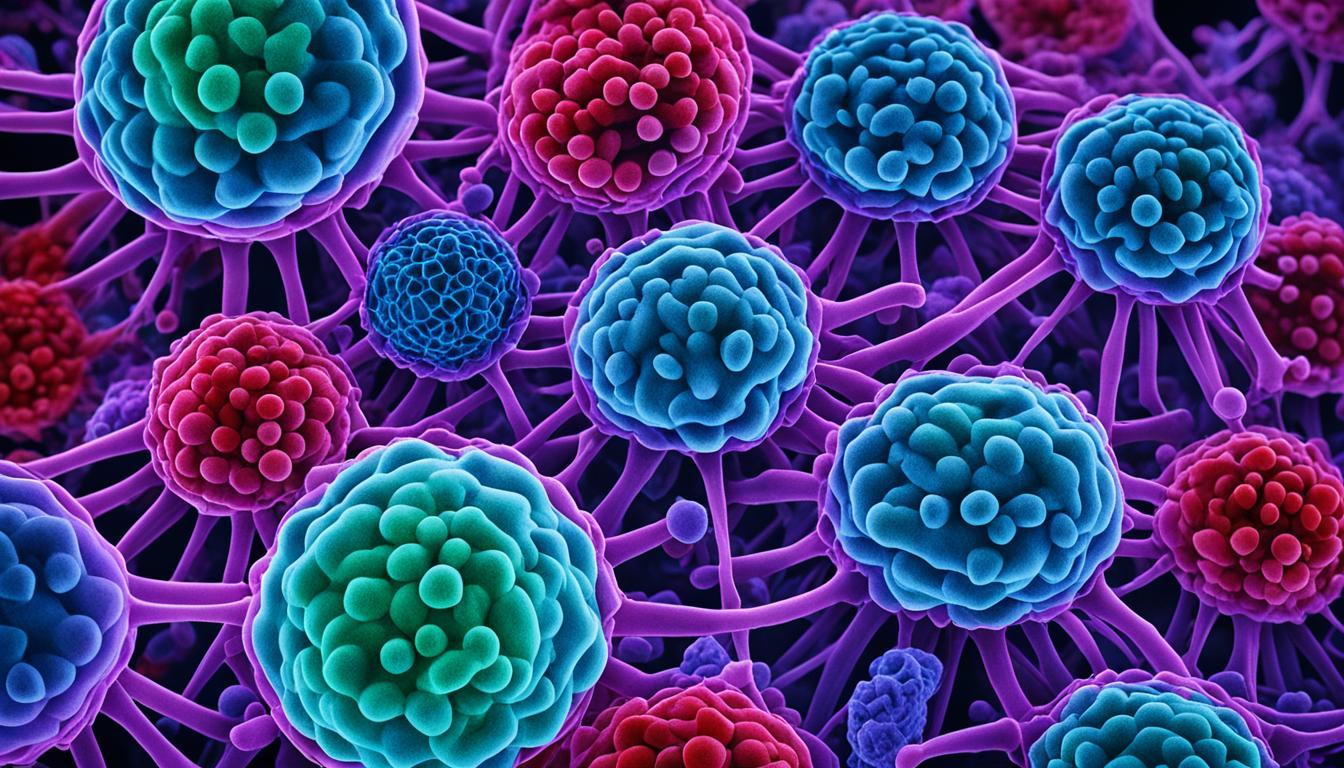Desmoid tumors are rare neoplasms from fibroblasts and myofibroblasts. They can form anywhere in the body. Most are found in the small bowel mesentery (80%) or in the abdominal wall/extremities (20-30%) (First source).
According to the World Health Organization, desmoid tumors are a type of aggressive fibromatosis. They are known for their slow growth, invasiveness, and minimal spreading to other parts of the body (First source).
These tumors come in various histological patterns. Some look like fibromatosis, myxoid, sclerosing, or mesenchymal neoplasms. This can make them seem like other health issues like nodular fasciitis, scar tissue, or low-grade tumors such as neurofibromas (First source).
Key Takeaways:
- Desmoid tumors are rare neoplasms that arise from fibroblasts and myofibroblasts.
- About 80% of desmoid tumors are localized in the small bowel mesentery.
- The World Health Organization classifies desmoid tumors as aggressive fibromatosis.
- Desmoid tumors can have different histological patterns.
- Desmoid tumors can mimic other conditions, making diagnosis challenging.
Symptoms and Diagnosis of Desmoid Tumors
Desmoid tumors are usually firm and painless, feeling like hard lumps. They might make you uncomfortable or restrict your movement, depending on where they are. These tumors can vary in size and where they show up, affecting the symptoms you might notice.
To diagnose a desmoid tumor, doctors first check you over and ask about your health. They use imaging studies like MRIs and look closely at a small piece of the tumor under a microscope (biopsy). Special tests on the biopsy, like looking for certain proteins, can help tell if it’s a desmoid tumor. They may also do genetic tests. This checks for changes in a gene linked with these tumors in some families.
Diagnostic protocols for desmoid tumors
Doctors have a special way of figuring out if you have a desmoid tumor. They use a step-by-step process that includes:
- A close checkup and talk about your health to see if you might have these tumors.
- Tests like MRIs to get a better look at the tumors.
- Taking a small piece of the tumor to look at it more closely.
- A special test to see unique proteins, helping to confirm the diagnosis.
- Looking at your genes may also be part of the process, searching for specific changes.
By using these steps, doctors can find out if you have a desmoid tumor for sure. This helps them plan the right treatment for you.
| Diagnostic Protocols for Desmoid Tumors | Description |
|---|---|
| Clinical evaluation | A thorough physical examination and medical history review. |
| Imaging studies | Using imaging techniques such as MRI to visualize and assess the tumors. |
| Biopsy | Collecting a tissue sample for examination under a microscope. |
| Immunohistochemical staining | Highlighting specific proteins in the tissue sample for confirmation of diagnosis. |
| Genetic testing | Checking for mutations in the APC gene, associated with familial adenomatous polyposis. |
Treatment and Management of Desmoid Tumors
Desmoid tumors are managed with various treatment options. These options depend on the tumor’s size, location, and how fast it’s growing. Patient’s choices also play a big role in choosing the right treatment.
Surgical Resection
For desmoid tumors, wide local excision is the best surgical option. This means removing the tumor and a bit of the healthy tissue around it. Doing this serves to make sure the tumor is fully gone. But sometimes, even after surgery, these tumors can come back.
Radiation Therapy
When surgery can’t fully remove the tumor, or if it’s likely to come back, radiation therapy might be used after. This treatment method uses high-energy beams to kill the remaining cancer cells. It can help lower the chances of the tumor returning and make managing the disease easier.
Medical Interventions
Aside from surgery and radiation, doctors look into other ways to treat desmoid tumors. They might give patients NSAIDs to help with pain and swelling. Hormone therapy has been successful in some cases. There’s also ongoing research on using certain drugs to target the tumors directly.
Prognosis for Desmoid Tumors
Desmoid tumors usually have a good long-term outlook. But they can come back, making their management tricky. It’s important to keep a close eye on the situation and work closely with the healthcare team. This approach ensures the best treatment outcomes and catches any problems early.
| Treatment Option | Description |
|---|---|
| Surgical Resection | Wide local excision with negative margins. |
| Radiation Therapy | Adjuvant radiation to reduce recurrence risk. |
| Medical Interventions | NSAIDs, hormonal therapy, targeted therapies. |
Innovative Approaches: Stem Cell Therapy for Desmoid Tumors
In the last few years, stem cell therapy has become a new way to treat desmoid tumors. This method aims at the cells that start these tumors, which could mean a better way to fight this rare cancer.
Tests done before in labs have shown that aiming at these specific cells works well. This success leads to more research into how well this new therapy really works.
Now, doctors are testing this therapy on real people to see if it’s safe and works. If this proves true, it might offer a gentler way to treat these tumors without the need for some surgeries.
A big win with stem cell therapy could change how we treat desmoid tumors. This new treatment could bring real change, offering better lives to those with desmoid tumors.

